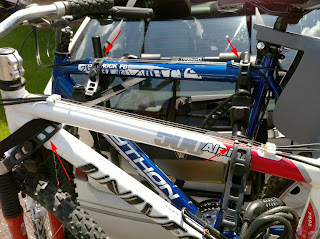Bike Rack on a Rover 200
I needed a bike rack to use on our Honda Accord sedan so I did some research and ended up with a
Hollywood Racks Model Express 3 bike rack. I then purchased a 1997 Rover 220 (bubble type) and hoped the bike carrier would work with it. Sure enough, it did and it's been great in carrying our two bikes (one with a child seat). You can see by the pics that it'd be pretty hard/impossible to have a third bike on the carrier with the other two bikes (mainly because one has a car seat on it).
Some general info:
Car: 1997 Rover 220
Rack: Hollywood Racks Express 3 bike rack
Bikes used: 22" Python Mountain bike, 18" Univega women's mountain bike
Child carrier used: Bell Cocoon deluxe 500 child carrier
Tools used:
None. Just use your hands.
1. Out of the box, this is what it looks like:
2. For fitting on my Rover 220, I adjusted the rack frame so the frame forms less than a 90 degree angle. From the instruction manual: loosen the black hubs by turning the hub adjustment
knobs counter-clockwise. This will allow the two sections of the rack frame to move relative to one another
for correct rack placement on your vehicle.
The hubs unloosened. The hubs tightened so that the teeth lock.

Angle of rack ready to be placed.
Another pic.
3. Fitting on the car: I started with the upper straps. The metal hooks slide into place over the hatch.
4. I attached the side straps the corners of the hatch. Here's a picture of the left and right straps.
5. Finally, I attached the bottom straps. Be sure to rest the bottom bracket on the lip of the license plate depression area. As mentioned in the manual, the rack needs to rest on the steel of the hatch/lid, NOT on the glass (unless you want to break your back window). Arrows point to the bottom straps.
6. Here's a picture of the installed racks with arrows to all the straps. Be sure to tighten them.
The top brace gently resting on the glass.
7. Attaching the bikes. As stated in the manual, be sure to load the heaviest bike first. I used the rubber straps to strap over the top tube of the first bike. Be sure to not route the straps over cables.
Loading the second bike. This is a woman's mountain bike so the right strap went over the top tube and the left strap went over the bottom tube.

Arrows to all the straps. Note the bottom tube on the woman's mountain bike strapped to keep the bike level. Be sure to retighten after all the bikes are loaded.
After the bikes were strapped in, there's a final nylon strap that the manual says to wrap around all the bikes. I weaved it through the front wheels of both bikes and pulled to keep the front forks/wheels from moving during transit. Here's what the car looks like fully loaded. The child seat I'm using on the mountain bike is a
Bell 500 Cocoon carrier.
View from the rear view mirror. I was afraid I wasn't going to be able to see over the bikes, but I was wrong! Great visibility!
That's it. We've really enjoyed the ease of use with the carrier. Reviews have mentioned that the straps get loose after 50 or so miles of driving and people are afraid that the bikes will rattle off on the highway. We've had no such experience with the straps loosening. I'd probably check a couple of times on a long road trip though, just to make sure. Removing the carrier is also super easy as well. I hope you fellow rover 200/rover 25/rover 220/bubble type rovers can use this info.
Cheers.



















































